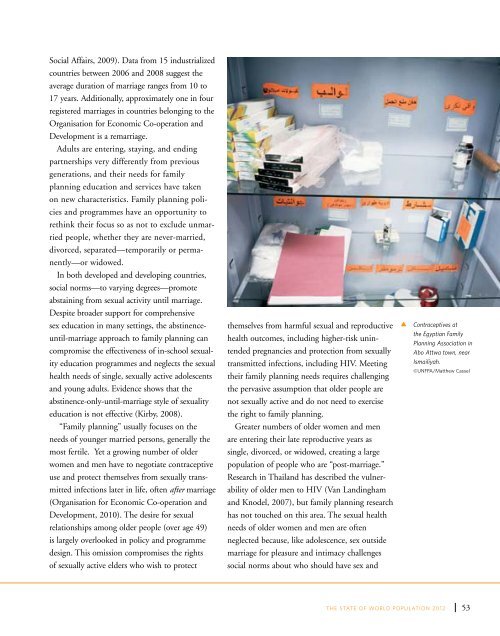State of World Population 2012 - Country Page List - UNFPA
State of World Population 2012 - Country Page List - UNFPA
State of World Population 2012 - Country Page List - UNFPA
Create successful ePaper yourself
Turn your PDF publications into a flip-book with our unique Google optimized e-Paper software.
Social Affairs, 2009). Data from 15 industrialized<br />
countries between 2006 and 2008 suggest the<br />
average duration <strong>of</strong> marriage ranges from 10 to<br />
17 years. Additionally, approximately one in four<br />
registered marriages in countries belonging to the<br />
Organisation for Economic Co-operation and<br />
Development is a remarriage.<br />
Adults are entering, staying, and ending<br />
partnerships very differently from previous<br />
generations, and their needs for family<br />
planning education and services have taken<br />
on new characteristics. Family planning policies<br />
and programmes have an opportunity to<br />
rethink their focus so as not to exclude unmarried<br />
people, whether they are never-married,<br />
divorced, separated—temporarily or permanently—or<br />
widowed.<br />
In both developed and developing countries,<br />
social norms—to varying degrees—promote<br />
abstaining from sexual activity until marriage.<br />
Despite broader support for comprehensive<br />
sex education in many settings, the abstinenceuntil-marriage<br />
approach to family planning can<br />
compromise the effectiveness <strong>of</strong> in-school sexuality<br />
education programmes and neglects the sexual<br />
health needs <strong>of</strong> single, sexually active adolescents<br />
and young adults. Evidence shows that the<br />
abstinence-only-until-marriage style <strong>of</strong> sexuality<br />
education is not effective (Kirby, 2008).<br />
“Family planning” usually focuses on the<br />
needs <strong>of</strong> younger married persons, generally the<br />
most fertile. Yet a growing number <strong>of</strong> older<br />
women and men have to negotiate contraceptive<br />
use and protect themselves from sexually transmitted<br />
infections later in life, <strong>of</strong>ten after marriage<br />
(Organisation for Economic Co-operation and<br />
Development, 2010). The desire for sexual<br />
relationships among older people (over age 49)<br />
is largely overlooked in policy and programme<br />
design. This omission compromises the rights<br />
<strong>of</strong> sexually active elders who wish to protect<br />
themselves from harmful sexual and reproductive<br />
health outcomes, including higher-risk unintended<br />
pregnancies and protection from sexually<br />
transmitted infections, including HIV. Meeting<br />
their family planning needs requires challenging<br />
the pervasive assumption that older people are<br />
not sexually active and do not need to exercise<br />
the right to family planning.<br />
Greater numbers <strong>of</strong> older women and men<br />
are entering their late reproductive years as<br />
single, divorced, or widowed, creating a large<br />
population <strong>of</strong> people who are “post-marriage.”<br />
Research in Thailand has described the vulnerability<br />
<strong>of</strong> older men to HIV (Van Landingham<br />
and Knodel, 2007), but family planning research<br />
has not touched on this area. The sexual health<br />
needs <strong>of</strong> older women and men are <strong>of</strong>ten<br />
neglected because, like adolescence, sex outside<br />
marriage for pleasure and intimacy challenges<br />
social norms about who should have sex and<br />
t<br />
Contraceptives at<br />
the Egyptian Family<br />
Planning Association in<br />
Abo Attwa town, near<br />
Ismailiyah.<br />
©<strong>UNFPA</strong>/Matthew Cassel<br />
THE STATE OF WORLD POPULATION <strong>2012</strong><br />
53
















